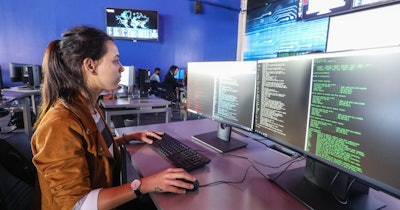
The report, "Creating the AI-Enabled Community College: A Road Map for Using Generative AI To Accelerate Student Success," released this month by the organization's AI for All Task Force, found that 70% of recent graduates believe AI should be integrated into courses, while only 14% of faculty feel confident using AI in their instruction.
"There's a clear disconnect between the frenetic rate of adoption of AI by students and the far slower movement to use AI by faculty and colleges," the report states. "With constant advances in the development and use of AI, colleges that fail to act risk continuing to prepare students for a world that is quickly fading away."
The 36-page report presents an eight-point framework for community colleges to strategically integrate AI while addressing concerns about equity, academic integrity, and workforce preparation. The recommendations come as Microsoft's 2024 Work Trend Index found that 66% of business leaders wouldn't hire someone without AI skills.
The task force, chaired by ATD Senior Fellow Gregory Haile and established by ATD President and CEO Dr. Karen A. Stout, emphasizes that AI implementation must prioritize students "often left behind by the design of our systems and programs."
"The pace of change has the potential to exacerbate existing educational inequities unless it is implemented intentionally to strengthen student success and increase social and economic mobility," the report warns.
The framework calls for ensuring all students—including those in degree and non-degree pathways—develop "AI agility," defined as the capacity to continuously adapt skills and workflows as AI capabilities expand, going beyond basic AI literacy.
Eight Action Areas
The report's framework centers on eight interconnected action areas:
- Strategic Leadership: Establishing comprehensive AI strategies aligned with institutional priorities
- Ethical AI Governance: Developing policies addressing data privacy, academic integrity, and bias mitigation
- Assessment and Impact Measurement: Creating metrics to evaluate AI's effect on different student populations
- Staff Capability Building: Training student services and technical staff in AI-enhanced support systems
- Faculty Professional Development: Providing hands-on training and communities of practice
- Curriculum Redesign: Integrating AI across disciplines while maintaining academic integrity
- Workforce Alignment: Partnering with employers to develop AI-powered microcredentials
- Student Success Investment: Deploying AI tools for personalized learning and early intervention
The report acknowledges widespread faculty concerns about AI's impact on academic integrity, noting that 42% of instructors completely prohibit student use of generative AI, according to a 2024 Ithaka S+R survey.
Rather than prohibition, the framework recommends "establishing and clearly communicating expectations for use of AI to encourage dynamic uses and ensure academic integrity." This includes teaching students to cite AI sources and understand the technology's limitations.
"Establishing and maintaining a culture of academic integrity has always been critical for colleges and universities. AI requires that institutions strengthen that culture," the report states.
The report includes an appendix detailing AI capabilities employers increasingly seek, including prompt design, human-AI collaboration, ethical discernment, and continuous learning abilities.
Research cited in the report shows AI adoption occurring at twice the pace of previous transformative technologies, with a 39.5% adoption rate after two years compared to 20% for the internet and personal computers.
"By 2030, up to 12 million occupational transitions may be required in the U.S., driven by automation and generative AI," the report notes, positioning community colleges as crucial for worker retraining and upskilling.
The framework emphasizes AI's potential to support community colleges' diverse student populations through multilingual capabilities, accessibility accommodations, and personalized learning paths that adapt to students juggling work, family, and educational responsibilities.
Predictive analytics could identify at-risk students earlier, while AI-powered tutoring and advising systems could provide 24/7 support beyond traditional office hours—particularly beneficial for working adults and parents.
Despite AI's potential benefits, the report also acknowledges significant implementation challenges, including the need for substantial faculty development, infrastructure investments, and careful attention to bias in AI systems.
"Unchecked AI systems can perpetuate biases, undermine equity, and erode trust," the authors warn, calling for continuous human oversight and regular bias audits.
The report recommends that colleges assess their financial capacity for AI integration, including costs for technology upgrades, data management systems, and professional development.
Achieving the Dream, which works with more than 300 community colleges nationwide, plans to integrate AI agility into its coaching and support services while developing professional learning opportunities around the eight action areas.
"Community colleges are in the early stages of a multiyear AI phenomenon but need to take action now to secure their future," the report concludes. "Failing to take advantage of the positive aspects of generative AI will risk leaving more students behind, sending students to work unprepared, and further eroding confidence in higher education."









